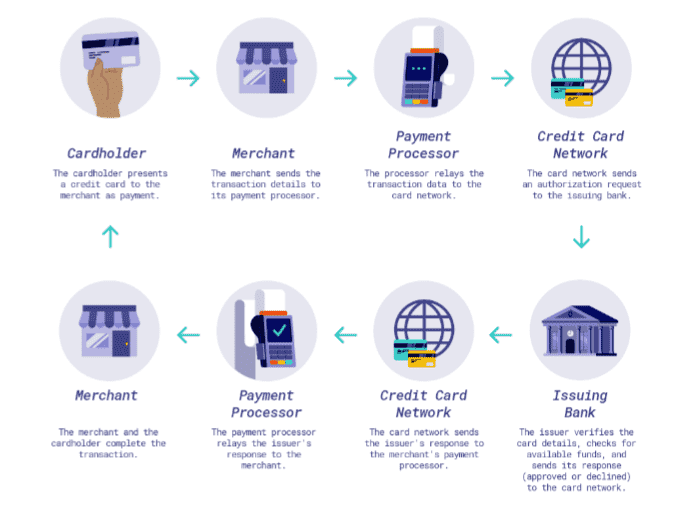Visa’s foray into the world of cryptocurrency is indeed a bold move, and it speaks volumes about the company’s recognition of the technological potential of digital currencies.
In recent weeks, they’ve unveiled an application that facilitates Visa card transactions in currencies like the dollar and euro on the Ethereum network. Yes, you heard that right, they’re harnessing Ethereum’s blockchain technology!
Just yesterday, they made another groundbreaking announcement, revealing their ability to perform similar transactions using the Solana blockchain.
According to their claims, Visa has already moved millions of USDC (a stablecoin pegged to the dollar) among its partners on both the Solana and Ethereum networks for payment settlement.
The clearing process is executed through VisaNet and applies to transactions involving traditional (fiat) currencies.
So, why is Visa diving headfirst into the world of crypto?
When we use Visa cards to make purchases at any of the millions of POS terminals worldwide, we experience the convenience of almost instantaneous payments.
However, what may seem like a swift payment to us consumers is actually far from complete.

It takes days or even weeks for the settlement to occur among banking institutions, reaching the final stage.
And of course, with multiple intermediaries involved, costs escalate, impacting both the company and consumers, especially when currency conversion is part of the money transfer.
This is where cryptocurrency technology promises to provide a solution. By using stablecoins like USDC and global blockchain networks such as Solana and Ethereum, the processes are streamlined and expedited, as stated by Cuy Sheffield, Head of Visa’s Crypto Division.
The pilot program was conducted in collaboration with Crypto.com, an initiative that commenced trials in 2021, making Visa one of the pioneering major payment companies experimenting with stablecoin transactions.
As they report, the venture has been a success. Previously, cross-border payments made with Crypto.com’s Visa cards required a complex currency conversion process that took many days and expensive international bank transfers.
Now, Crypto.com uses USDC to meet Visa card regulations in Australia and plans to expand this capability to other markets.
“We are excited that the collaboration between Circle (the company behind USDC) and Visa has led to innovations in the blockchain technology sector,” said Jeremy Allaire, Co-founder and CEO of Circle.
He added, “The expansion of the pilot program is an example of how the combination of USDC with Visa’s innovative applications showcases the future of payments, commerce, and financial applications.”
As Visa ventures further into this technology, they are exploring the possibility of transferring stablecoins even faster and at lower costs. That’s why they’ve chosen to add the Solana network, providing partners with the option to send or receive USDC payments.
Solana’s blockchain averages a staggering 400 transactions per second (TPS), further enhancing the speed of money transfers.
Efforts to create an efficient and secure bridge between traditional banking and the Web3 world seem to be paying off for Visa.
However, it’s not all sunshine and roses for Solana. The daily active addresses on its network continue to decline.
In August, the 7-day average dropped to 204,000, the lowest since data tracking began at the end of 2020. Solana is paying the price for its close association with Sam Bankman-Fried and the FTX group. Funding and support were cut, tarnishing its reputation. To make matters worse, the U.S. Securities and Exchange Commission labeled Solana as a debt security.
All these factors have driven its price well below the $265 peak it reached in November 2021. Today, it trades at around $20, as seen in the 4-hour chart below.
🔴 READ ALSO
- Solana’s Rocky Ride: Overcoming Regulatory Waves, Soaring Towards Growth
- Solana (SOL) Price Today | Solana Technical Analysis | SOL/USD
- Solana’s Saga Phone with Simplified Web3 Experience Now Available for Public Orders
- Solana Empowers ChatGPT: OpenAI’s Chatbot Gains Access to Solana Blockchain Functions
- Solana’s Resilience in the Wake of FTX Collapse
Previous Articles:
- ElmonX Unveils ‘Moona Lisa’: A Digital Collection by World-Famous Street Artist Nick Walker
- Turkey’s Soaring Inflation Drives Surge in Cryptocurrency Adoption
- Elon Musk’s X Platform Secures Rhode Island License for Crypto Transactions
- Bitcoin’s Soaring Surge: Grayscale ETF Decision Sparks Market Optimism
- FastVPN Review: Should You Trust This VPN From Namecheap?
